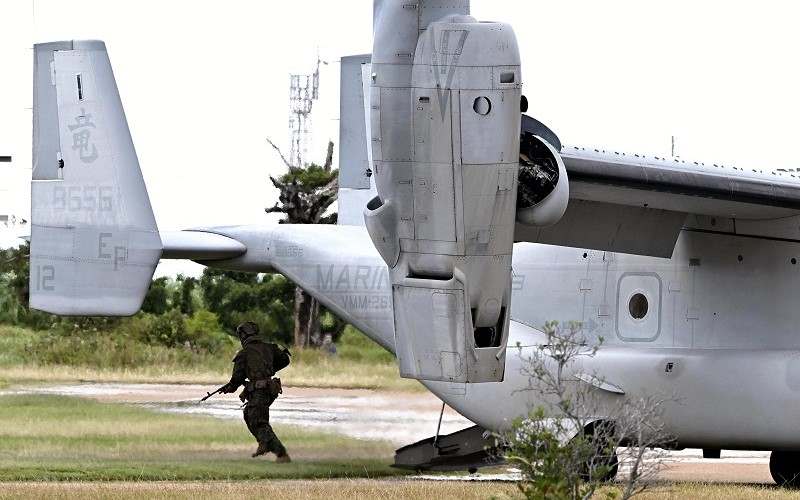Defense Perspective: In the field / Keen Sword demonstrates strength of Japan-U.S. ties, stance on China

U.S. marines alight from an MV22 Osprey aircraft during a military drill on Tokunoshima island, Kagoshima Prefecture, on Nov. 18.
15:50 JST, December 12, 2022
This is the first installment in a series that will monitor ongoing international developments and identify necessary tasks if Japan were to become embroiled in a contingency. This will involve putting a spotlight on the Self-Defense Forces, which play a fundamental role in Japan’s defense; the defense industries and the Japan Coast Guard, which jointly support national security along with the SDF; and measures to protect the public in the event of a national emergency.
***
If China tries to absorb Taiwan by force, Japan may become involved in a major contingency. And if the Chinese military was to attempt to deter a counteroffensive by U.S. forces stationed in Japan, it is possible that Chinese forces would try to occupy part of the Nansei Islands.
In the U.S. National Security Strategy issued in October, the administration of U.S. President Joe Biden emphasized the importance of “integrated deterrence,” which aims to unite allies’ military might and advanced technologies.
The Japan-U.S. security alliance is a keystone of China-focused deterrence, and the SDF and U.S. forces aim to strengthen this tie-up through further collaboration.
There were 25 Japan-U.S. joint military drills in fiscal 2014. However, this number jumped dramatically following Japan’s establishment of security-related laws in 2015. In Fiscal 2021, there were 86 such drills.
The Nansei Islands serves as a front line in these efforts. From Nov. 10-19, Keen Sword 23 — the largest Japan-U.S. joint military exercise of it’s kind held in Japan — was conducted mainly in Kagoshima and Okinawa prefectures.
About 26,000 SDF members and about 10,000 U.S. military personnel participated in the drills, which were based on actual-battle scenarios.
On Nov. 18, a U.S. MV22 Osprey transport aircraft approached Tokunoshima Island in Kagoshima Prefecture. With a low buzzing sound, the Osprey slowly descended and made a smooth landing, guided by Ground Self-Defense Force personnel.
The hatch at the rear of the aircraft opened, and 14 U.S. marines bearing assault rifles jumped from the plane and ran into nearby bushes. Their role in the drill was to ambush the “enemy” from behind, based on the premise that hostile forces had landed and concealed themselves on a remote Japan island.
As part of Keen Sword, the SDF and U.S. forces also carefully mulled operational decisions and processes related to supplies.
Ospreys from both the SDF and U.S. forces were simultaneously employed in the Nansei Islands for the first time. A GSDF Type 16 maneuver combat vehicle was airlifted to Yonaguni Island — located on Japan’s westernmost tip — and ran on a public road in a new first.
Such exercises likely demonstrated to China that Japan and the United States are collaborating closely and assuming the possibility of actual conflict.
Speaking at a press conference on Nov. 17, GSDF Chief of Staff Yoshihide Yoshida said, “The SDF has been strengthening its defense capabilities in the Nansei Islands, and it’s meaningful from the perspective of enhancing defense-preparedness that we were able to carry out Keen Sword there to help aid the integration of operations.”
Japan and the United States continue to prioritize their alliance with an eye on a possible contingency.
"Politics" POPULAR ARTICLE
-

Japan to Support Central Asian Logistics Route That Bypasses Russia, Plan to Be Part of Upcoming Summit in Tokyo
-

Japan to Tighten Screening of Foreigners’ Residential Status by Providing Information of Nonpayment of Taxes
-

Chinese, Russian Bombers Flew Unusual Path by Heading Toward Tokyo; Move Likely Meant to Intimidate Japan
-

Japan Plans National Database to Track Foreign Ownership of Real Estate, Land as It Weighs New Rules
-

Up to 199,000 Deaths Estimated From Mega-Tsunami; Most Recent Occurrence Took Place in 17th Century
JN ACCESS RANKING
-

Tokyo Economic Security Forum to Hold Inaugural Meeting Amid Tense Global Environment
-

Keidanren Chairman Yoshinobu Tsutsui Visits Kashiwazaki-Kariwa Nuclear Power Plant; Inspects New Emergency Safety System
-

Imports of Rare Earths from China Facing Delays, May Be Caused by Deterioration of Japan-China Relations
-

University of Tokyo Professor Discusses Japanese Economic Security in Interview Ahead of Forum
-

Japan Pulls out of Vietnam Nuclear Project, Complicating Hanoi’s Power Plans
























